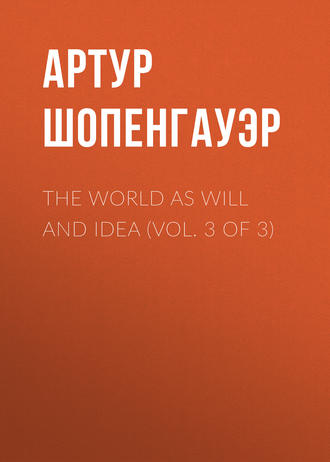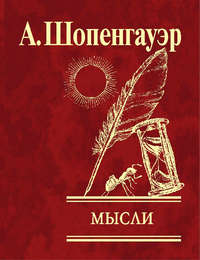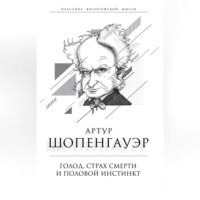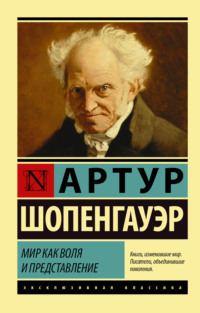 полная версия
полная версияThe World as Will and Idea (Vol. 3 of 3)
The great difference between the English, or more correctly the Chinese, garden and the old French, which is now always becoming more rare, yet still exists in a few magnificent examples, ultimately rests upon the fact that the former is planned in an objective spirit, the latter in a subjective. In the former the will of nature, as it objectifies itself in tree and shrub, mountain and waterfall, is brought to the purest possible expression of these its Ideas, thus of its own inner being. In the French garden, on the other hand, only the will of the possessor of it is mirrored, which has subdued nature so that instead of its Ideas it bears as tokens of its slavery the forms which correspond to that will, and which are forcibly imposed upon it – clipped hedges, trees cut into all kinds of forms, straight alleys, arched avenues, &c.
Chapter XXXIV.18 On The Inner Nature Of Art
Not merely philosophy but also the fine arts work at bottom towards the solution of the problem of existence. For in every mind that once gives itself up to the purely objective contemplation of nature a desire has been excited, however concealed and unconscious it may be, to comprehend the true nature of things, of life and existence. For this alone has interest for the intellect as such, i. e., for the pure subject of knowledge which has become free from the aims of the will; as for the subject which knows as a mere individual the aims of the will alone have interest. On this account the result of the purely objective apprehension of things is an expression more of the nature of life and existence, more an answer to the question, “What is life?” Every genuine and successful work of art answers this question in its own way with perfect correctness. But all the arts speak only the naive and childish language of perception, not the abstract and serious language of reflection; their answer is therefore a fleeting image: not permanent and general knowledge. Thus for perception every work of art answers that question, every painting, every statue, every poem, every scene upon the stage: music also answers it; and indeed more profoundly than all the rest, for in its language, which is understood with absolute directness, but which is yet untranslatable into that of the reason, the inner nature of all life and existence expresses itself. Thus all the other arts hold up to the questioner a perceptible image, and say, “Look here, this is life.” Their answer, however correct it may be, will yet always afford merely a temporary, not a complete and final, satisfaction. For they always give merely a fragment, an example instead of the rule, not the whole, which can only be given in the universality of the conception. For this, therefore, thus for reflection and in the abstract, to give an answer which just on that account shall be permanent and suffice for always, is the task of philosophy. However, we see here upon what the relationship of philosophy to the fine arts rests, and can conclude from that to what extent the capacity of both, although in its direction and in secondary matters very different, is yet in its root the same.
Every work of art accordingly really aims at showing us life and things as they are in truth, but cannot be directly discerned by every one through the mist of objective and subjective contingencies. Art takes away this mist.
The works of the poets, sculptors, and representative artists in general contain an unacknowledged treasure of profound wisdom; just because out of them the wisdom of the nature of things itself speaks, whose utterances they merely interpret by illustrations and purer repetitions. On this account, however, every one who reads the poem or looks at the picture must certainly contribute out of his own means to bring that wisdom to light; accordingly he comprehends only so much of it as his capacity and culture admit of; as in the deep sea each sailor only lets down the lead as far as the length of the line will allow. Before a picture, as before a prince, every one must stand, waiting to see whether and what it will speak to him; and, as in the case of a prince, so here he must not himself address it, for then he would only hear himself. It follows from all this that in the works of the representative arts all truth is certainly contained, yet only virtualiter or implicite; philosophy, on the other hand, endeavours to supply the same truth actualiter and explicite, and therefore, in this sense, is related to art as wine to grapes. What it promises to supply would be, as it were, an already realised and clear gain, a firm and abiding possession; while that which proceeds from the achievements and works of art is one which has constantly to be reproduced anew. Therefore, however, it makes demands, not only upon those who produce its works, but also upon those who are to enjoy them which are discouraging and hard to comply with. Therefore its public remains small, while that of art is large.
The co-operation of the beholder, which is referred to above, as demanded for the enjoyment of a work of art, depends partly upon the fact that every work of art can only produce its effect through the medium of the fancy; therefore it must excite this, and can never allow it to be left out of the play and remain inactive. This is a condition of the æsthetic effect, and therefore a fundamental law of all fine arts. But it follows from this that, through the work of art, everything must not be directly given to the senses, but rather only so much as is demanded to lead the fancy on to the right path; something, and indeed the ultimate thing, must always be left over for the fancy to do. Even the author must always leave something over for the reader to think; for Voltaire has very rightly said, “Le secret d'être ennuyeux, c'est de tout dire.” But besides this, in art the best of all is too spiritual to be given directly to the senses; it must be born in the imagination of the beholder, although begotten by the work of art. It depends upon this that the sketches of great masters often effect more than their finished pictures; although another advantage certainly contributes to this, namely, that they are completed offhand in the moment of conception; while the perfected painting is only produced through continued effort, by means of skilful deliberation and persistent intention, for the inspiration cannot last till it is completed. From the fundamental æsthetical law we are speaking of, it is further to be explained why wax figures never produce an æsthetic effect, and therefore are not properly works of fine art, although it is just in them that the imitation of nature is able to reach its highest grade. For they leave nothing for the imagination to do. Sculpture gives merely the form without the colour; painting gives the colour, but the mere appearance of the form; thus both appeal to the imagination of the beholder. The wax figure, on the other hand, gives all, form and colour at once; whence arises the appearance of reality, and the imagination is left out of account. Poetry, on the contrary, appeals indeed to the imagination alone, which it sets in action by means of mere words.
An arbitrary playing with the means of art without a proper knowledge of the end is, in every art, the fundamental characteristic of the dabbler. Such a man shows himself in the pillars that support nothing, aimless volutes, juttings and projections of bad architecture, in the meaningless runs and figures, together with the aimless noise of bad music, in the jingling of the rhymes of senseless poetry, &c.
It follows from the preceding chapter, and from my whole view of art, that its aim is the facilitating of the knowledge of the Ideas of the world (in the Platonic sense, the only one which I recognise for the word Idea). The Ideas, however, are essentially something perceptible, which, therefore, in its fuller determinations, is inexhaustible. The communication of such an Idea can therefore only take place on the path of perception, which is that of art. Whoever, therefore, is filled with the comprehension of an Idea is justified if he chooses art as the medium of its communication. The mere conception, on the other hand, is something completely determinable, therefore exhaustible, and distinctly thought, the whole content of which can be coldly and dryly expressed in words. Now to desire to communicate such a conception by means of a work of art is a very useless circumlocution, indeed belongs to that playing with the means of art without knowledge of its end which has just been condemned. Therefore a work of art which has proceeded from mere distinct conceptions is always ungenuine. If now, in considering a work of plastic art, or in reading a poem, or in hearing a piece of music (which aims at describing something definite), we see, through all the rich materials of art, the distinct, limited, cold, dry conception shine out, and at last come to the front, the conception which was the kernel of this work, the whole notion of which consequently consisted in the distinct thinking of it, and accordingly is absolutely exhausted by its communication, we feel disgusted and indignant, for we see ourselves deceived and cheated out of our interest and attention. We are only perfectly satisfied by the impression of a work of art when it leaves something which, with all our thinking about it, we cannot bring down to the distinctness of a conception. The mark of that hybrid origin from mere conceptions is that the author of a work of art could, before he set about it, give in distinct words what he intended to present; for then it would have been possible to attain his whole end through these words. Therefore it is an undertaking as unworthy as it is absurd if, as has often been tried at the present day, one seeks to reduce a poem of Shakspeare's or Goethe's to the abstract truth which it was its aim to communicate. Certainly the artist ought to think in the arranging of his work; but only that thought which was perceived before it was thought has afterwards, in its communication, the power of animating or rousing, and thereby becomes imperishable. We shall not refrain from observing here that certainly the work which is done at a stroke, like the sketches of painters already referred to, the work which is completed in the inspiration of its first conception, and as it were unconsciously dashed off, like the melody which comes entirely without reflection, and quite as if by inspiration, and finally, also the lyrical poem proper, the mere song, in which the deeply felt mood of the present, and the impression of the surroundings, as if involuntarily, pours itself forth in words, whose metre and rhyme come about of their own accord – that all these, I say, have the great advantage of being purely the work of the ecstasy of the moment, the inspiration, the free movement of genius, without any admixture of intention and reflection; hence they are through and through delightful and enjoyable, without shell and kernel, and their effect is much more inevitable than that of the greatest works of art, of slower and more deliberate execution. In all the latter, thus in great historical paintings, in long epic poems, great operas, &c., reflection, intention, and deliberate selection has had an important part; understanding, technical skill, and routine must here fill up the gaps which the conception and inspiration of genius has left, and must mix with these all kinds of necessary supplementary work as cement of the only really genuinely brilliant parts. This explains why all such works, only excepting the perfect masterpieces of the very greatest masters (as, for example, “Hamlet,” “Faust,” the opera of “Don Juan”), inevitably contain an admixture of something insipid and wearisome, which in some measure hinders the enjoyment of them. Proofs of this are the “Messiah,” “Gerusalemme liberata,” even “Paradise Lost” and the “Æneid;” and Horace already makes the bold remark, “Quandoque dormitat bonus Homerus.” But that this is the case is the consequence of the limitation of human powers in general.
The mother of the useful arts is necessity; that of the fine arts superfluity. As their father, the former have understanding; the latter genius, which is itself a kind of superfluity, that of the powers of knowledge beyond the measure which is required for the service of the will.
Chapter XXXV.19 On The Æsthetics Of Architecture
In accordance with the deduction given in the text of the pure æsthetics of architecture from the lowest grades of the objectification of the will or of nature, the Ideas of which it seeks to bring to distinct perception, its one constant theme is support and burden, and its fundamental law is that no burden shall be without sufficient support, and no support without a suitable burden; consequently that the relation of these two shall be exactly the fitting one. The purest example of the carrying out of this theme is the column and entablature. Therefore the order or columnar arrangement has become, as it were, the thorough bass of the whole of architecture. In column and entablature the support and the burden are completely separated; whereby the reciprocal action of the two and their relation to each other becomes apparent. For certainly even every plain wall contains support and burden; but here the two are still fused together. All is here support and all is burden; hence there is no æsthetic effect. This first appears through the separation, and takes place in proportion to its degree. For between the row of columns and the plain wall there are many intermediate degrees. Even in the mere breaking up of the wall of a house by windows and doors one seeks at least to indicate that separation by flat projecting pilasters (antæ) with capitals, which are inserted under the mouldings, nay, in case of need, are represented by mere painting, in order to indicate in some way the entablature and an order. Real pillars, and also consoles and supports of various kinds, realise more that pure separation of support and burden which is striven after throughout by architecture. In this respect, next to the column with the entablature, but as a special construction not imitating it, stands the vault with the pillar. The latter certainly is far from attaining to the æsthetic effect of the former, because here the support and the burden are not purely separated, but are fused, passing over into each other. In the vault itself every stone is at once burden and support, and even the pillars, especially in groined vaulting, are, at least apparently, held in position by the pressure of opposite arches; and also just on account of this lateral pressure not only vaults but even mere arches ought not to rest upon columns, but require the massive four-cornered pillars. In the row of columns alone is the separation complete, for here the entablature appears as pure burden, the column as pure support. Accordingly the relation of the colonnade to the plain wall may be compared to that which would exist between a scale ascending in regular intervals and a tone ascending little by little from the same depth to the same height without gradation, which would produce a mere howl. For in the one as in the other the material is the same, and the important difference proceeds entirely from the pure separation.
Moreover, the support is not adapted to the burden when it is only sufficient to bear it, but when it can do this so conveniently and amply that at the first glance we are quite at ease about it. Yet this superfluity of support must not exceed a certain degree; for otherwise we will perceive support without burden, which is opposed to the æsthetic end. As a rule for determining that degree the ancients devised the line of equilibrium, which is got by carrying out the diminution of the thickness of the column as it ascends till it runs out into an acute angle, whereby the column becomes a cone; now every cross section will leave the lower part so strong that it is sufficient to support the upper part cut off. Commonly, however, one builds with twentyfold strength, i. e., one lays upon every support only 1/20th of the maximum it could bear. A glaring example of burden without support is presented to the eye by the balconies at the corners of many houses built in the elegant style of the present day. We do not see what supports them; they seem to hang suspended, and disturb the mind.
That in Italy even the simplest and most unornamented buildings make an æsthetic impression, while in Germany this is not the case, depends principally upon the fact that in Italy the roofs are very flat. A high roof is neither support nor burden, for its two halves mutually support each other, but the whole has no weight corresponding to its extension. Therefore it presents to the eye an extended mass which is entirely foreign to the æsthetic end, serves merely a useful end, consequently disturbs the former, of which the theme is always only support and burden.
The form of the column has its sole ground in the fact that it affords the simplest and most suitable support. In the twisted column inappropriateness appears as if with intentional perversity, and therefore shamelessness: hence good taste condemns it at the first glance. The four-cornered pillar, since the diagonal exceeds the sides, has unequal dimensions of thickness which have no end as their motive, but are occasioned by the accident of greater feasibleness; and just on this account it pleases us so very much less than the column. Even the hexagonal or octagonal pillar is more pleasing, because it approaches more nearly to the round column; for the form of the latter alone is exclusively determined by the end. It is, however, also so determined in all its other proportions, primarily in the relation of its thickness to its height, within the limits permitted by the difference of the three columnar orders. Therefore its diminution from the first third of its height upwards, and also a slight increase of its thickness just at this place (entasis vitr.), depends upon the fact that the pressure of the burden is greatest there. It has hitherto been believed that this increase in thickness was peculiar to the Ionic and Corinthian columns alone, but recent measurements have shown it also in the Doric columns, even at Pæstum. Thus everything in the column, its thoroughly determined form, the proportion of its height to its thickness, of both to the intervals between the columns, and that of the whole series to the entablature and the burden resting upon it, is the exactly calculated result of the relation of the necessary support to the given burden. As the latter is uniformly distributed, so must also the support be; therefore groups of columns are tasteless. On the other hand, in the best Doric temples the corner column comes somewhat nearer to the next ones, because the meeting of the entablatures at the corner increases the burden; and in this the principle of architecture expresses itself distinctly, that the structural relations, i. e., the relations between support and burden, are the essential ones, to which the relations of symmetry, as subordinate, must at once give way. According to the weight of the whole burden generally will the Doric or the two lighter orders of columns be chosen, for the first, not only by the greater thickness, but also by the closer position of the columns, which is essential to it, is calculated for heavier burdens, to which end also the almost crude simplicity of its capital is suited. The capitals in general serve the end of showing visibly that the columns bear the entablature, and are not stuck in like pins; at the same time they increase by means of their abacus the bearing surface. Since, then, all the laws of columnar arrangement, and consequently also the form and proportion of the column, in all its parts and dimensions down to the smallest details, follow from the thoroughly understood and consistently carried out conception of the amply adequate support of a given burden, thus so far are determined a priori, it comes out clearly how perverse is the thought, so often repeated, that the stems of trees, or even (which unfortunately even “Vitruvius,” iv. 1, expresses) the human form has been the prototype of the column. For if the form of the column were for architecture a purely accidental one, taken from without, it could never appeal to us so harmoniously and satisfactorily whenever we behold it in its proper symmetry; nor, on the other hand, could every even slight disproportion of it be felt at once by the fine and cultivated sense as disagreeable and disturbing, like a false note in music. This is rather only possible because, according to the given end and means, all the rest is essentially determined a priori, as in music, according to the given melody and key, the whole harmony is essentially so determined. And, like music, architecture in general is also not an imitative art, although both are often falsely taken to be so.
Æsthetic satisfaction, as was fully explained in the text, always depends upon the apprehension of a (Platonic) Idea. For architecture, considered merely as a fine art, the Ideas of the lowest grades of nature, such as gravity, rigidity, and cohesion, are the peculiar theme; but not, as has hitherto been assumed, merely regular form, proportion, and symmetry, which, as something purely geometrical, properties of space, are not Ideas, and therefore cannot be the theme of a fine art. Thus in architecture also they are of secondary origin, and have a subordinate significance, which I shall bring out immediately. If it were the task of architecture as a fine art simply to exhibit these, then the model would have the same effect as the finished work. But this is distinctly not the case; on the contrary, the works of architecture, in order to act æsthetically, absolutely must have a considerable size; nay, they can never be too large, but may easily be too small. Indeed ceteris paribus the æsthetic effect is in exact proportion to the size of the building, because only great masses make the action of gravitation apparent and impressive in a high degree. But this confirms my view that the tendency and antagonism of those fundamental forces of nature constitute the special æsthetical material of architecture, which, according to its nature, requires large masses in order to become visible, and indeed capable of being felt. The forms in architecture, as was shown above in the case of the column, are primarily determined by the immediate structural end of each part. But so far as this leaves anything undetermined, the law of the most perfect clearness to perception, thus also of the easiest comprehensibility, comes in; for architecture has its existence primarily in our spatial perception, and accordingly appeals to our a priori faculty for this. But these qualities always result from the greatest regularity of the forms and rationality of their relations. Therefore beautiful architecture selects only regular figures composed of straight lines or regular curves, and also the bodies which result from these, such as cubes, parallelopipeda, cylinders, spheres, pyramids, and cones; but as openings sometimes circles or ellipses, yet, as a rule, quadrates, and still oftener rectangles, the latter of thoroughly rational and very easily comprehended relation of their sides (not, for instance as 6:7, but as 1:2, 2:3), finally also blind windows or niches of regular and comprehensible proportions. For the same reason it will readily give to the buildings themselves and their large parts a rational and easily comprehended relation of height and breadth; for example, it will let the height of a facade be half the breadth, and place the pillars so that every three or four of them, with the intervals between them, will measure a line which is equal to the height, thus will form a quadrate. The same principle of perceptibility and easy comprehension demands also that a building should be easily surveyed. This introduces symmetry, which is further necessary to mark out the work as a whole, and to distinguish its essential from its accidental limitation; for sometimes, for example, it is only under the guidance of symmetry that one knows whether one has before one three buildings standing beside each other or only one. Thus only by means of symmetry does a work of architecture at once announce itself as individual unity, and as the development of a central thought.









